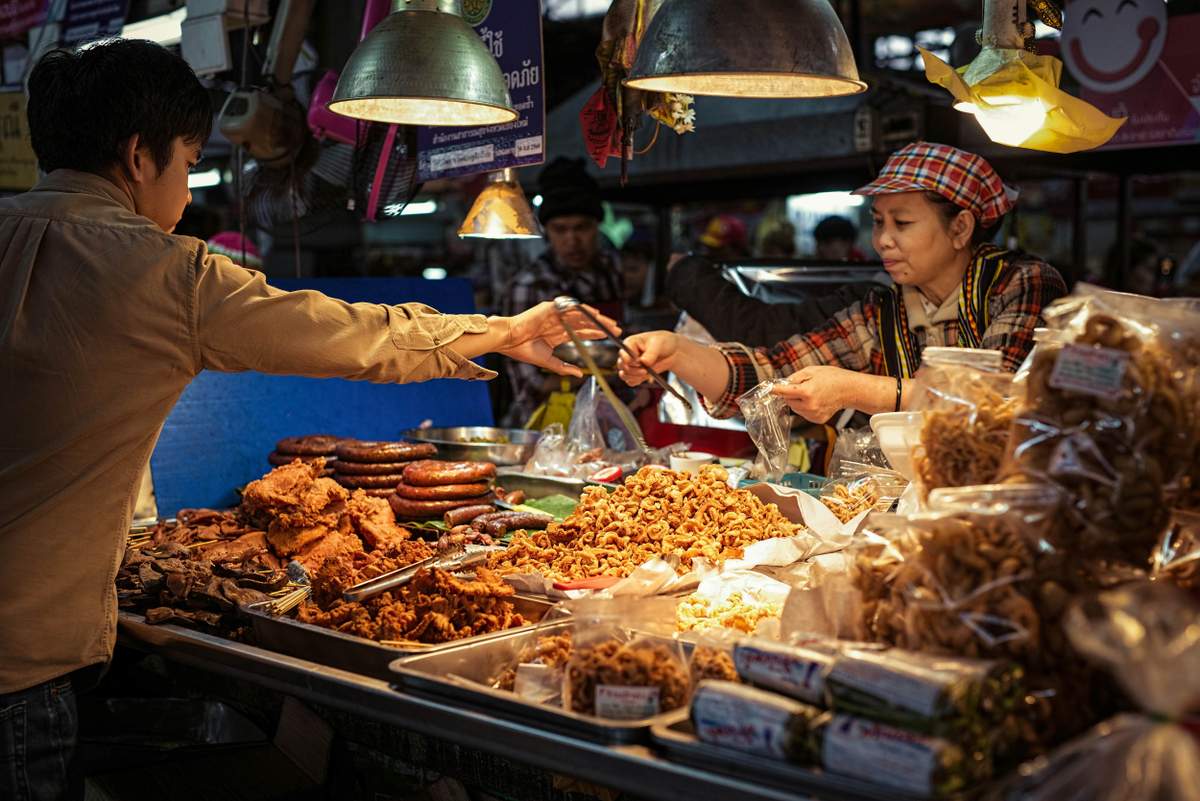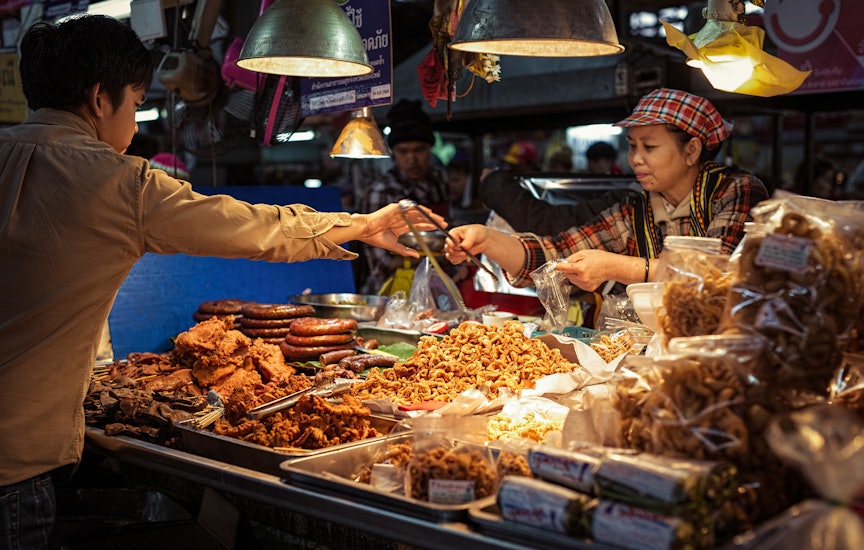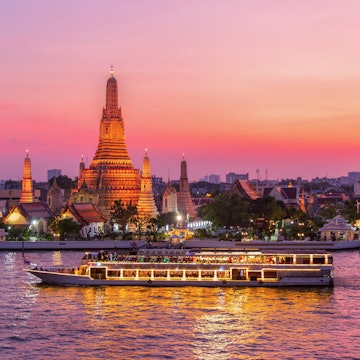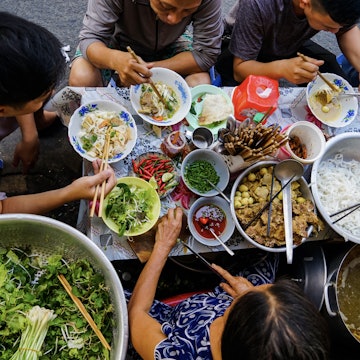

Sunday Walking Street market, Chiang Mai. 501room/Shutterstock
There’s so much more to Chiang Mai, Thailand’s Rose of the North, than first meets the eye. Though firmly on the Thai travel circuit, Chiang Mai often comes in third for visitors determined to see Bangkok before immediately heading south to the tropical islands.
Those who trek north, however, are certainly rewarded. Here, countless historic temples, street stalls, jungle-covered hills, artisan workshops, street markets and more coffee shops than you ever thought were possible are packed into a relatively small area – the Old City is just one square mile. A few days here can stretch into a week… and then two… or more.
Lucky enough to call Chiang Mai home for a decade, I still find it endlessly captivating. Here’s are my top tips on planning, etiquette and safety to help you make the most of your stay.

Planning your trip to Chiang Mai
1. Don't forget Chiang Mai is both a city and a province
As is typical for Thailand, the province name is also the name of its largest hub. (Other examples include the city of Chiang Rai in Chiang Rai Province or the island of Phuket in Phuket Province.) Keep this in mind while booking transportation or accommodations.
2. Do allow at least 5 days in the city
A few days isn’t enough to uncover Chiang Mai’s charms, which often lie in its daily rhythms. Do yourself a favor and plan to stay for at least 5 nights or even more, if possible. Between exploring town and squeezing in a couple of day trips, there are plenty of ways to fill your stay. Also, time your visit to stay over the weekend since some of the city’s night markets only happen on Saturdays and Sundays.
Practical advice once you're in Chiang Mai
3. Don't make plans for every day
Spending a leisurely morning over elaborate coffee concoctions at a picture-perfect cafe, treating yourself to a 2-hour massage and fitting in a cooking or yoga class – Chiang Mai natives and transplants take their reputation for appreciating “slow living” seriously, and you should, too. Keep at least 1 day unscheduled to simply wander, enjoy the relaxed pace, and stay open to whatever serendipitous encounter or decision may unfold.

4. Do visit the markets
There’s truly a market, or talat, happening morning, noon and night. Various fresh markets will open before dawn and close by late morning, while others open in the afternoon and early evening for the after-work rush. Meanwhile, Talat Muang Mai, a wholesale produce market, stays open all day and is particularly busy late at night when farmers arrive from the surrounding hills hauling their latest crop.
Talat Wororot, also known as Kad Luang in the northern dialect, on the east side of town along the Mae Ping River, is Chiang Mai’s longest running market and still a popular local destination for everything from home goods and flower garlands during the day to clothes and streetside fare during the evening.
As the sun sets, a number of Chiang Mai night markets pop up. You’ll find clusters of street food stalls, many of which have had the same vendors for a decade or more, at Talat Pratu Chiang Mai or Talat Pratu Chang Pheuak while the weekend Saturday Walking Street and Sunday Walking Street are popular spots for locals, Thai tourists and foreign visitors alike.
5. Don't miss northern Thai food
Eating may be Thailand’s national pastime, but Chiang Mai’s bounty of nearby farms harvesting fresh produce, countless street stalls, and affordable prices (you can still find bowls of noodle soup for just a dollar or two) take it to a new level. You’re never far from another satisfying snack, memorable meal or refreshing beverage.
Known for using lots of herbs, spice and pork, northern Thai food tends to have a unique funkiness to it that you won’t find elsewhere. You’ve probably heard of kôw soy, the Chiang Mai specialty of egg noodles topped with a rich curry broth and pickled garnishes, but that’s just the beginning. Look for kaffir lime leaf-stuffed sai oui sausage, spicy green chili dip known as nám prík nùm, roasted tomato and ground pork chili dip called naam prik ong, and kà·nŏm jeen nám ngée·o, thin sticky rice noodles topped with a spicy, tomato-based broth.
Tong Tem Toh in the Nimmanhaemin neighborhood and Huen Phen in the Old City are both solid places to start your northern Thai culinary journey.

6. Do brave the crowds during holidays and celebrations
Songkran, Thailand’s new year celebration held each April, and Loi Krathong, in November, are both widely celebrated across Chiang Mai with parades around the Old City, elaborate decorations, city-wide events, and lots of photo ops. Loi Krathong in Chiang Mai is particularly beautiful, thanks in part to the added northern holiday of Yee Peng and countless illuminated paper lanterns released into the sky. While the town can start feeling a little overrun with visitors during these times, it’s worth the crowds for the close proximity to so many events and activities.
Etiquette in Chiang Mai
7. Do dress (relatively) modestly
Even in the height of the hot season, Thailand is a fairly modest country when it comes to clothing, particularly for women. This applies even more in the north, which is away from the beaches and often less-touristed than Bangkok and the islands. “Polite” dress – meaning covered shoulders, chests, and thighs – is required for visiting temples, but it's often expected in everyday life, too. That said, everyone tends to keep things comfortable and casual. No one will say anything (to your face) about what you’re wearing, but you’ll both show respect and often receive more respect when showing less skin.
Safety in Chiang Mai
8. Do seek health care locally if you need it
Good doctors and dentists are easily accessible in Chiang Mai. While you hopefully won’t have to go to the doctor for any reason, if you get sick or hurt, you can easily walk into any hospital and get care. This includes the city’s go-to, private hospital for foreigners and locals with money to spare, Chiang Mai Ram, which is in the center of town. Find a check-in desk, and staff will point you in the right direction. Dentist offices are also dotted throughout the city and readily accept new patients. Due for a cleaning? This is the place to do it.

9. Don't panic if you're stopped at a police checkpoint
There are plenty of ways to get around Chiang Mai, from tuk-tuks (autorickshaws) to the local rot daang (literally "red trucks", which are shared taxis), and traffic is much calmer than in cities like Bangkok.
Zipping around town on a motorbike is arguably the quickest, most convenient way to get around – if you know what you’re doing! As a foreigner, however, you’ll likely get stopped at a police checkpoint. Unless you have a valid Thai motorbike license, you’ll often receive a ticket. Be polite, stay calm, and pay the fine. They’ll then let you keep driving on your merry way. Also, always wear a helmet. It’s the law, even though sometimes it seems more like a suggestion than a rule.
10. Do prepare for the "smoky season"
Thailand has three seasons – hot, rainy, and cold – but Chiang Mai also often experiences what locals call the “smoky season.” Often starting sometime in February and lasting through the hot season until the rains begin at the end of April or early May, Chiang Mai sees smoky skies and poor air quality from slash and burn farming practices. Every year is different depending on the weather patterns and the government’s current restrictions, but if you’ll be in Chiang Mai in February, March or April, you can expect some level of pollution. Face masks are readily available and most accommodations and indoor restaurants will have air purifiers running 24/7.
















